2021 HYUNDAI TUCSON HYBRID tow
[x] Cancel search: towPage 565 of 630
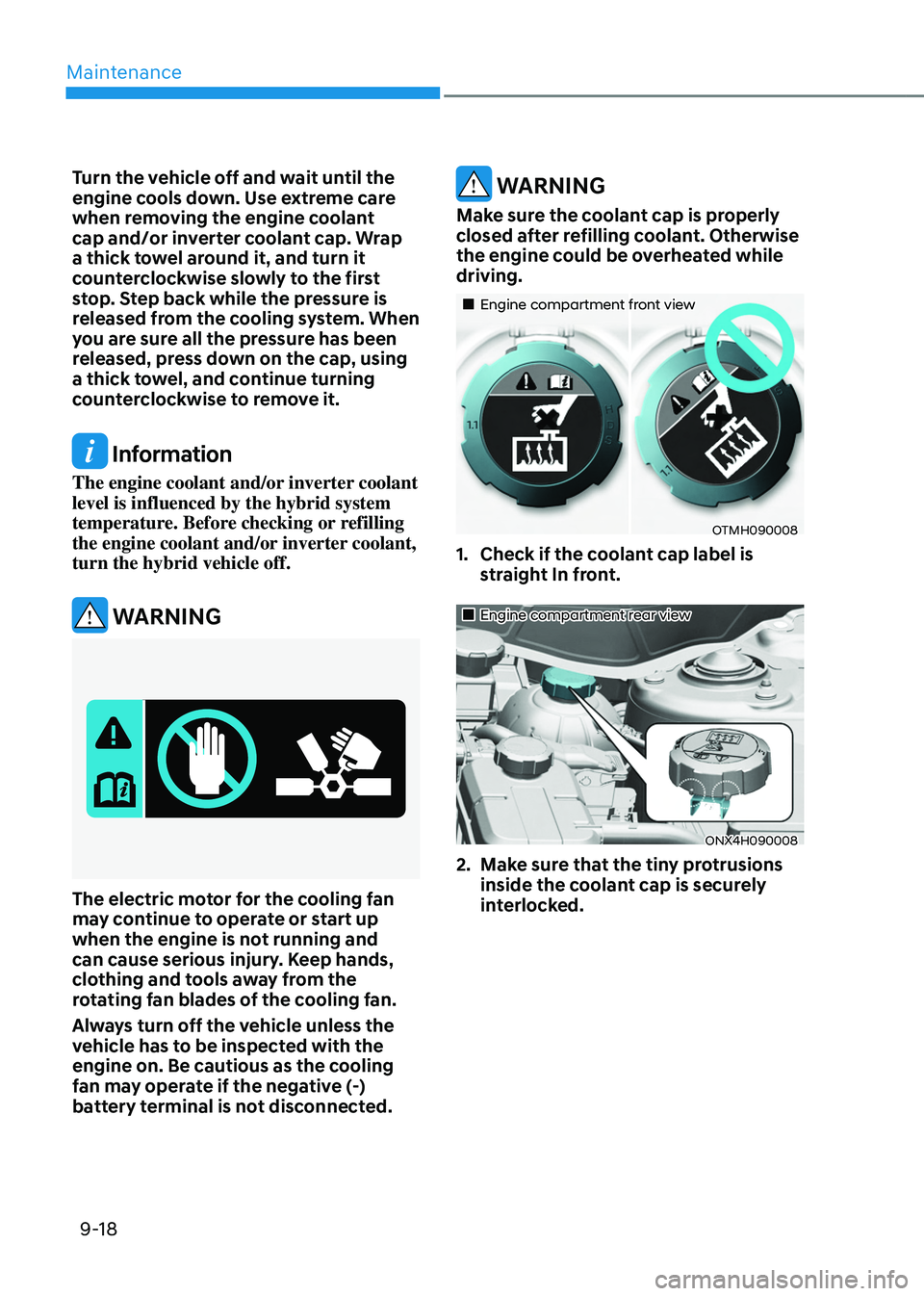
Maintenance
9-18
Turn the vehicle off and wait until the
engine cools down. Use extreme care
when removing the engine coolant
cap and/or inverter coolant cap. Wrap
a thick towel around it, and turn it
counterclockwise slowly to the first
stop. Step back while the pressure is
released from the cooling system. When
you are sure all the pressure has been
released, press down on the cap, using
a thick towel, and continue turning
counterclockwise to remove it.
Information
The engine coolant and/or inverter coolant
level is influenced by the hybrid system
temperature. Before checking or refilling
the engine coolant and/or inverter coolant,
turn the hybrid vehicle off.
WARNING
The electric motor for the cooling fan
may continue to operate or start up
when the engine is not running and
can cause serious injury. Keep hands,
clothing and tools away from the
rotating fan blades of the cooling fan.
Always turn off the vehicle unless the
vehicle has to be inspected with the
engine on. Be cautious as the cooling
fan may operate if the negative (-)
battery terminal is not disconnected.
WARNING
Make sure the coolant cap is properly
closed after refilling coolant. Otherwise
the engine could be overheated while
driving.
„„Engine compartment front view
OTMH090008
1. Check if the coolant cap label is
straight In front.
„„Engine compartment rear view
ONX4H090008
2. Make sure that the tiny protrusions
inside the c oolant cap is securely
interlocked.
Page 566 of 630
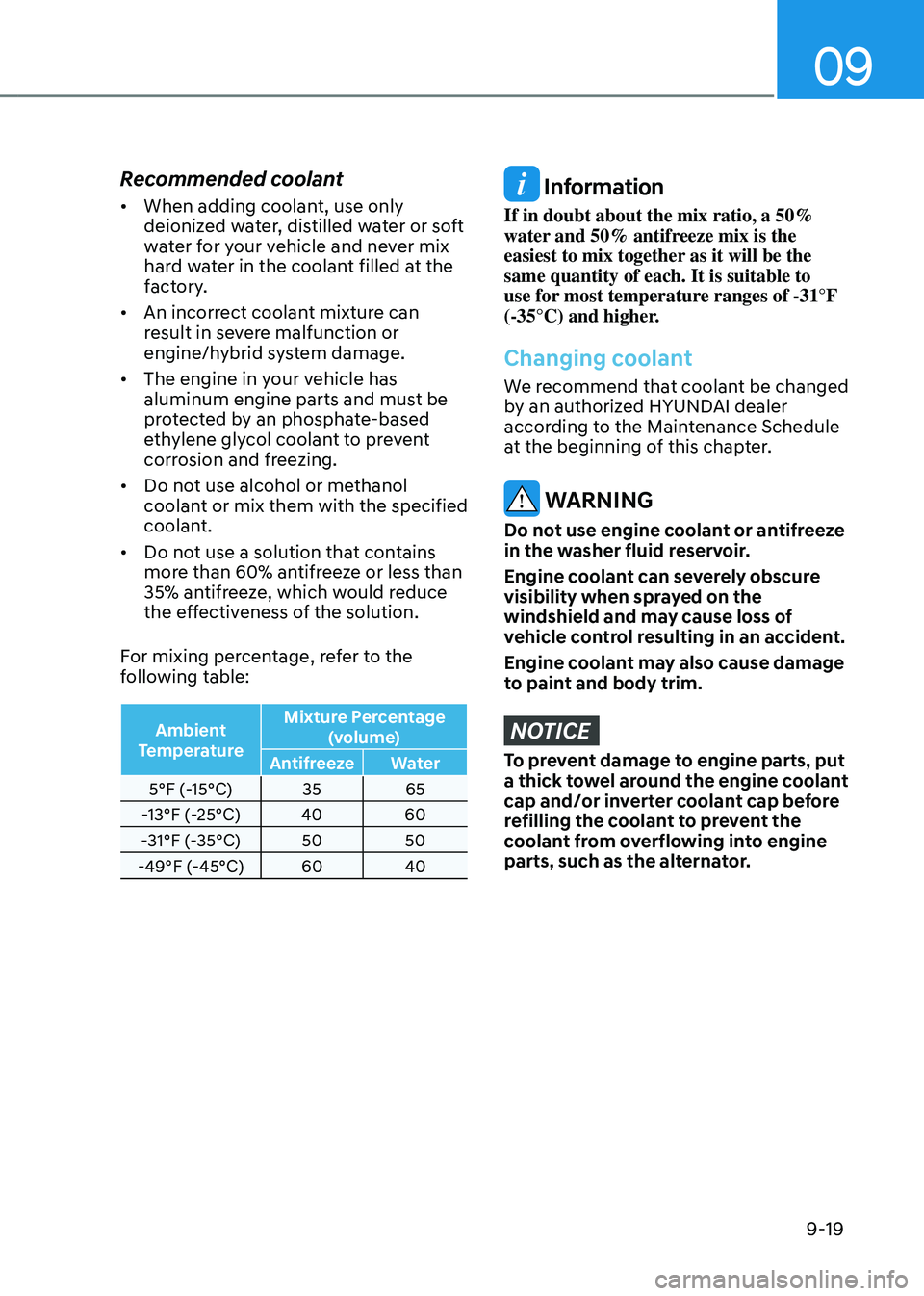
09
9-19
Recommended coolant
• When adding coolant, use only
deionized water, distilled water or soft
water for your vehicle and never mix
hard water in the coolant filled at the
factory.
• An incorrect coolant mixture can
result in severe malfunction or
engine/hybrid system damage.
• The engine in your vehicle has
aluminum engine parts and must be
protected by an phosphate-based
ethylene glycol coolant to prevent
corrosion and freezing.
• Do not use alcohol or methanol
coolant or mix them with the specified
coolant.
• Do not use a solution that contains
more than 60% antifreeze or less than
35% antifreeze, which would reduce
the effectiveness of the solution.
For mixing percentage, refer to the
following table:
Ambient
Temperature Mixture Percentage
(volume)
Antifreeze Water
5°F (-15°C) 35 65
-13°F (-25°C) 40 60
-31°F (-35°C) 50 50
-49°F (-45°C) 60 40
Information
If in doubt about the mix ratio, a 50%
water and 50% antifreeze mix is the
easiest to mix together as it will be the
same quantity of each. It is suitable to
use for most temperature ranges of -31°F
(-35°C) and higher.
Changing coolant
We recommend that coolant be changed
by an authorized HYUNDAI dealer
according to the Maintenance Schedule
at the beginning of this chapter.
WARNING
Do not use engine coolant or antifreeze
in the washer fluid reservoir.
Engine coolant can severely obscure
visibility when sprayed on the
windshield and may cause loss of
vehicle control resulting in an accident.
Engine coolant may also cause damage
to paint and body trim.
NOTICE
To prevent damage to engine parts, put
a thick towel around the engine coolant
cap and/or inverter coolant cap before
refilling the coolant to prevent the
coolant from overflowing into engine
parts, such as the alternator.
Page 574 of 630
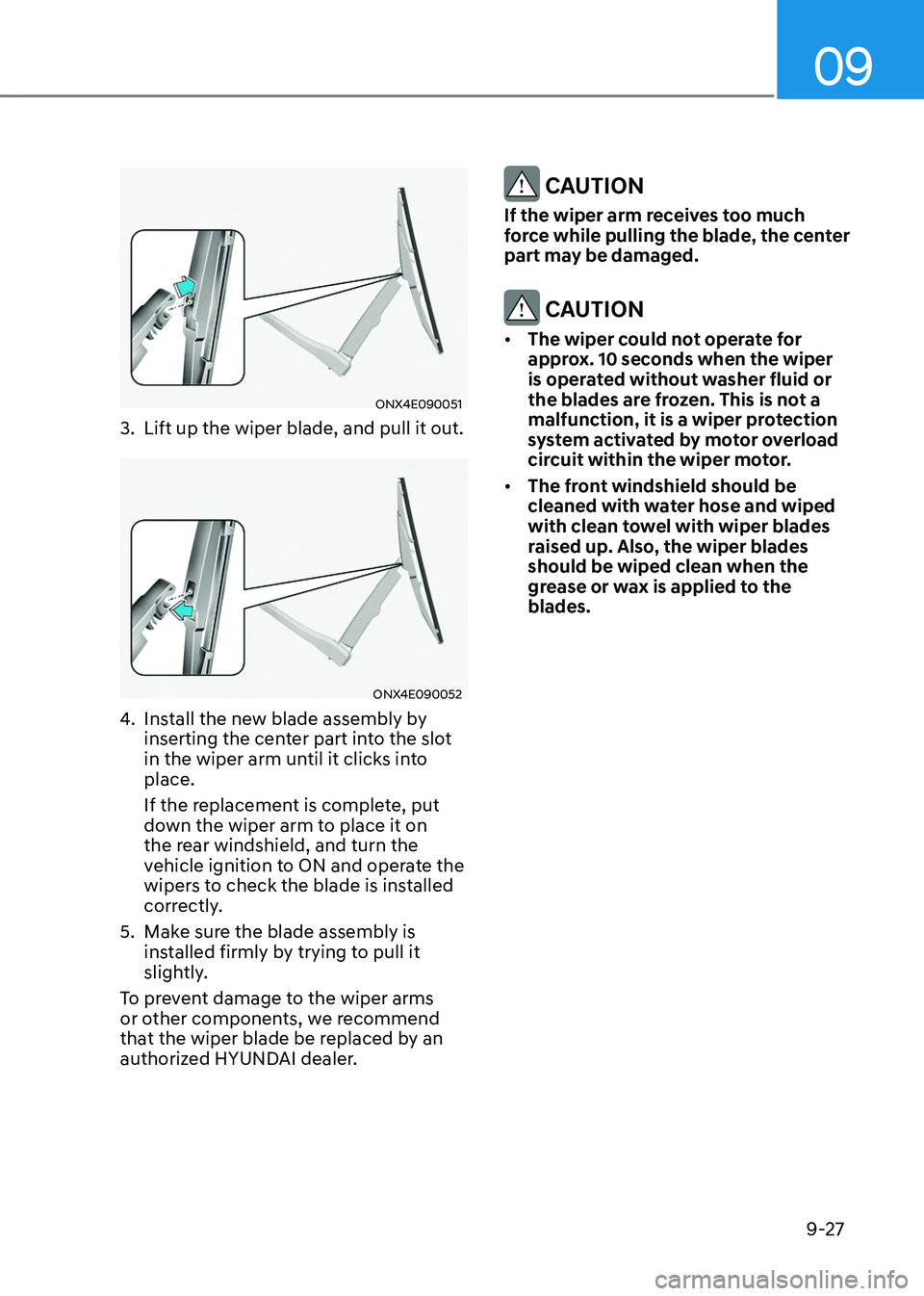
09
9-27
ONX4E090051
3. Lift up the wiper blade, and pull it out.
ONX4E090052
4. Install the new blade assembly by
inserting the center part into the slot
in the wiper arm until it clicks into
place.
If the replacement is complete, put
down the wiper arm to place it on
the rear windshield, and turn the
vehicle ignition to ON and operate the
wipers to check the blade is installed
correctly.
5.
Make sur
e the blade assembly is
installed firmly by trying to pull it
slightly.
To prevent damage to the wiper arms
or other components, we recommend
that the wiper blade be replaced by an
authorized HYUNDAI dealer.
CAUTION
If the wiper arm receives too much
force while pulling the blade, the center
part may be damaged.
CAUTION
• The wiper could not operate for
approx. 10 seconds when the wiper
is operated without washer fluid or
the blades are frozen. This is not a
malfunction, it is a wiper protection
system activated by motor overload
circuit within the wiper motor.
• The front windshield should be
cleaned with water hose and wiped
with clean towel with wiper blades
raised up. Also, the wiper blades
should be wiped clean when the
grease or wax is applied to the
blades.
Page 602 of 630
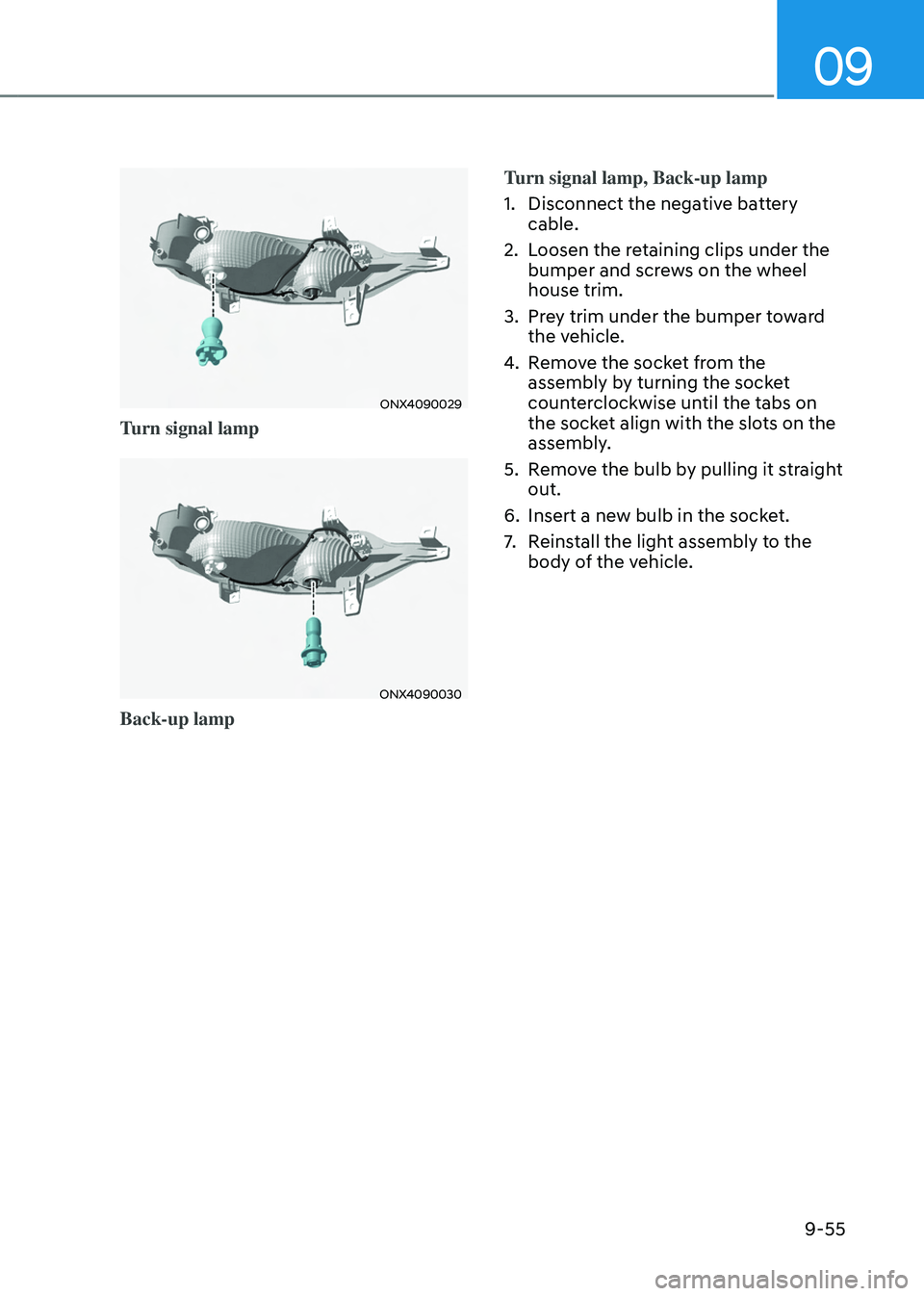
09
9-55
ONX4090029
Turn signal lamp
ONX4090030
Back-up lampTurn signal lamp, Back-up lamp
1.
Disconnect the negativ
e battery
cable.
2.
Loosen the r
etaining clips under the
bumper and screws on the wheel
house trim.
3.
Pre
y trim under the bumper toward
the vehicle.
4.
Remo
ve the socket from the
assembly by turning the socket
counterclockwise until the tabs on
the socket align with the slots on the
assembly.
5.
Remo
ve the bulb by pulling it straight
out.
6.
Insert a new bulb in the sock
et.
7.
Reins
tall the light assembly to the
body of the vehicle.
Page 607 of 630
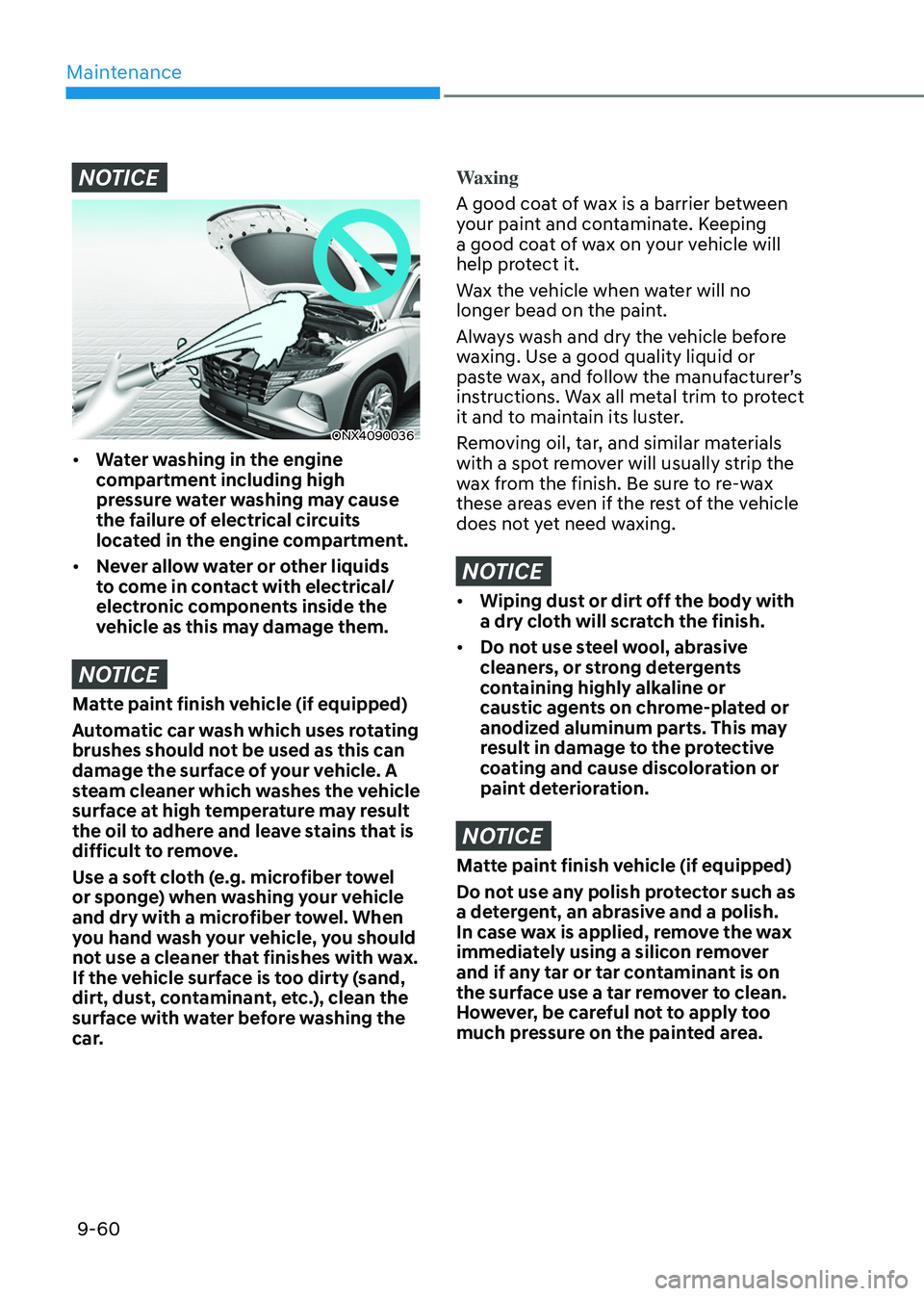
Maintenance
9-60
NOTICE
ONX4090036
• Water washing in the engine
compartment including high
pressure water washing may cause
the failure of electrical circuits
located in the engine compartment.
• Never allow water or other liquids
to come in contact with electrical/
electronic components inside the
vehicle as this may damage them.
NOTICE
Matte paint finish vehicle (if equipped)
Automatic car wash which uses rotating
brushes should not be used as this can
damage the surface of your vehicle. A
steam cleaner which washes the vehicle
surface at high temperature may result
the oil to adhere and leave stains that is
difficult to remove.
Use a soft cloth (e.g. microfiber towel
or sponge) when washing your vehicle
and dry with a microfiber towel. When
you hand wash your vehicle, you should
not use a cleaner that finishes with wax.
If the vehicle surface is too dirty (sand,
dirt, dust, contaminant, etc.), clean the
surface with water before washing the
car.
Waxing
A good coat of wax is a barrier between
your paint and contaminate. Keeping
a good coat of wax on your vehicle will
help protect it.
Wax the vehicle when water will no
longer bead on the paint.
Always wash and dry the vehicle before
waxing. Use a good quality liquid or
paste wax, and follow the manufacturer’s
instructions. Wax all metal trim to protect
it and to maintain its luster.
Removing oil, tar, and similar materials
with a spot remover will usually strip the
wax from the finish. Be sure to re-wax
these areas even if the rest of the vehicle
does not yet need waxing.
NOTICE
• Wiping dust or dirt off the body with
a dry cloth will scratch the finish.
• Do not use steel wool, abrasive
cleaners, or strong detergents
containing highly alkaline or
caustic agents on chrome-plated or
anodized aluminum parts. This may
result in damage to the protective
coating and cause discoloration or
paint deterioration.
NOTICE
Matte paint finish vehicle (if equipped)
Do not use any polish protector such as
a detergent, an abrasive and a polish.
In case wax is applied, remove the wax
immediately using a silicon remover
and if any tar or tar contaminant is on
the surface use a tar remover to clean.
However, be careful not to apply too
much pressure on the painted area.
Page 629 of 630
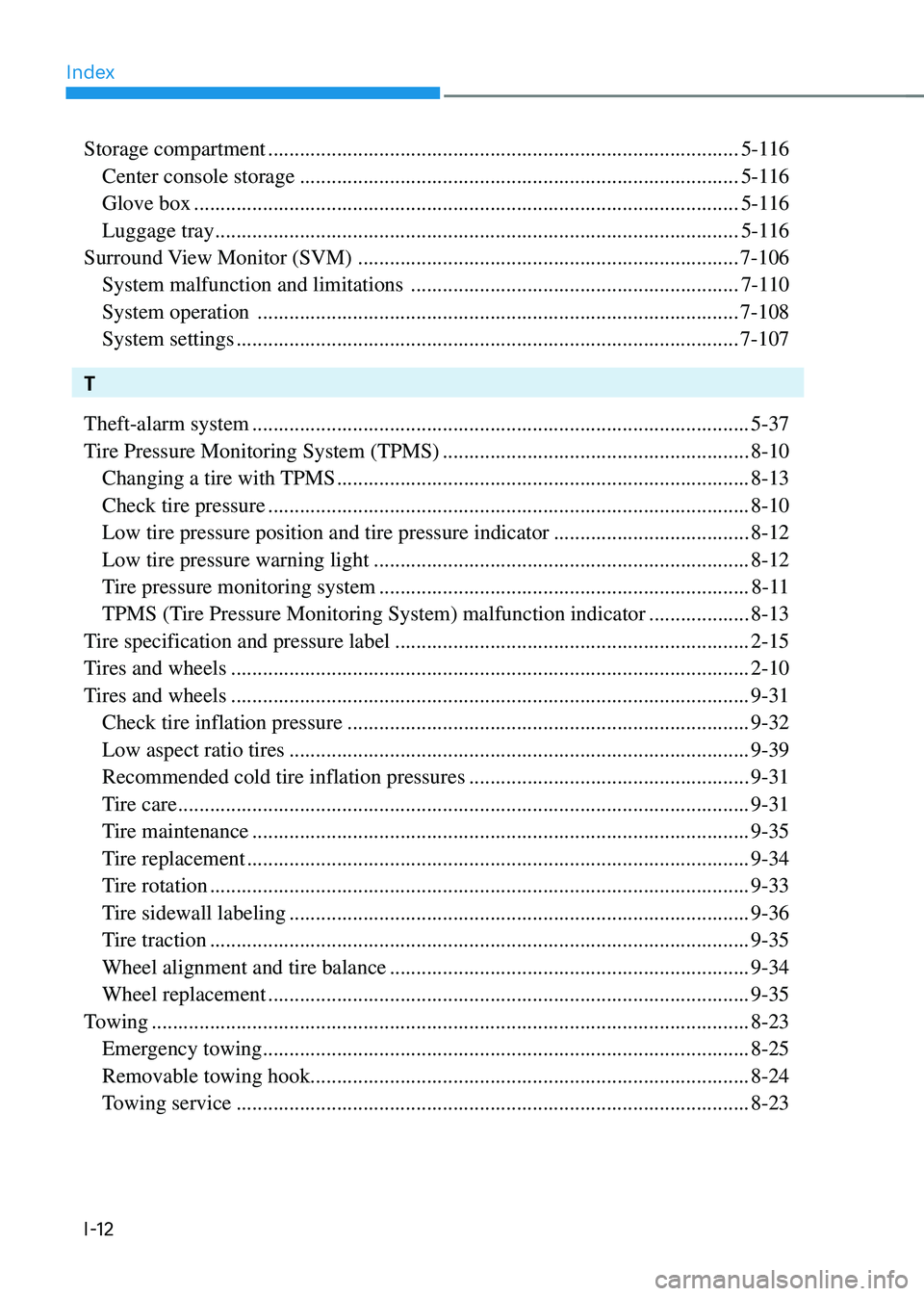
Index
I-12
Storage compartment ........................................................................\
.................5-116
Center console storage ........................................................................\
...........5-116
Glove box ........................................................................\
...............................5-116
Luggage tray ........................................................................\
...........................5-116
Surround View Monitor (SVM)
........................................................................\
7-106
System malfunction and limitations ..............................................................7-110
System operation ........................................................................\
...................7-108
System settings ........................................................................\
.......................7-107
T
Theft-alarm system
........................................................................\
......................5-37
Tire Pressure Monitoring System (TPMS)
..........................................................8-10
Changing a tire with TPMS ........................................................................\
......8-13
Check tire pressure ........................................................................\
...................8-10
Low tire pressure position and tire pressure indicator .....................................8-12
Low tire pressure warning light .......................................................................8-12
Tire pressure monitoring system ......................................................................8-11
TPMS (Tire Pressure Monitoring System) malfunction indicator ...................8-13
Tire specification and pressure label
...................................................................2-15
Tires and wheels
........................................................................\
..........................2-10
Tires and wheels
........................................................................\
..........................9-31
Check tire inflation pressure ........................................................................\
....9-32
Low aspect ratio tires ........................................................................\
...............9-39
Recommended cold tire inflation pressures .....................................................9-31
Tire care ........................................................................\
....................................9-31
Tire maintenance ........................................................................\
......................9-35
Tire replacement ........................................................................\
.......................9-34
Tire rotation ........................................................................\
..............................9-33
Tire sidewall labeling ........................................................................\
...............9-36
Tire traction ........................................................................\
..............................9-35
Wheel alignment and tire balance ....................................................................9-34
Wheel replacement ........................................................................\
...................9-35
Towing
........................................................................\
.........................................8-23
Emergency towing ........................................................................\
....................8-25
Removable towing hook ........................................................................\
...........8-24
Towing service ........................................................................\
.........................8-23
Page 630 of 630
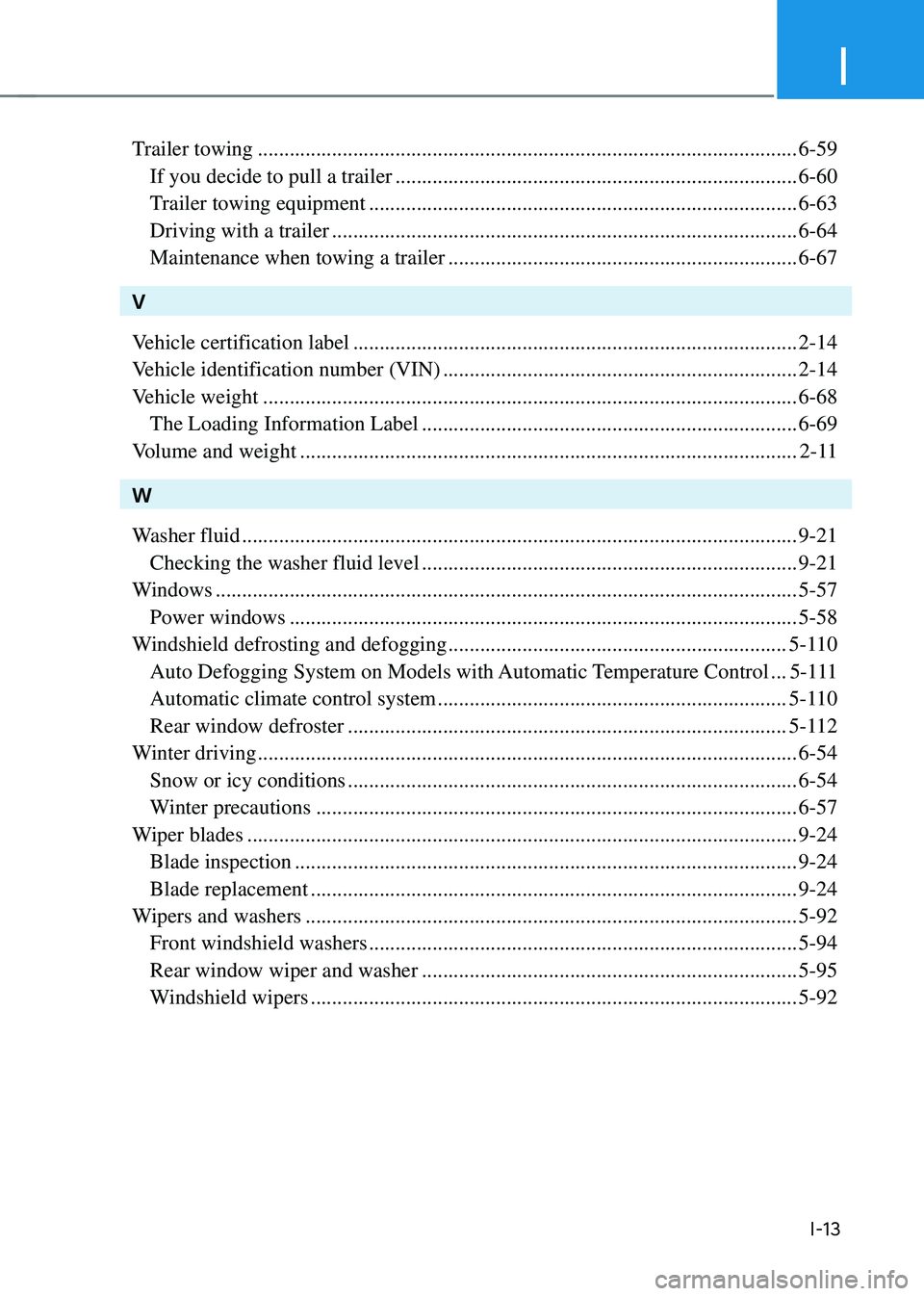
I
I-13
Trailer towing ........................................................................\
..............................6-59
If you decide to pull a trailer ........................................................................\
....6-60
Trailer towing equipment ........................................................................\
.........6-63
Driving with a trailer ........................................................................\
................6-64
Maintenance when towing a trailer ..................................................................6-67
V
Vehicle certification label
........................................................................\
............2-14
Vehicle identification number (VIN)
...................................................................2-14
Vehicle weight
........................................................................\
.............................6-68
The Loading Information Label .......................................................................6-69
Volume and weight
........................................................................\
......................2-11
W
Washer fluid
........................................................................\
.................................9-21
Checking the washer fluid level .......................................................................9-21
Windows
........................................................................\
......................................5-57
Power windows ........................................................................\
........................5-58
Windshield defrosting and defogging
................................................................5-110
Auto Defogging System on Models with Automatic Temperature Control ...5-111
Automatic climate control system ..................................................................5-110
Rear window defroster ........................................................................\
...........5-112
Winter driving
........................................................................\
..............................6-54
Snow or icy conditions ........................................................................\
.............6-54
Winter precautions ........................................................................\
...................6-57
Wiper blades
........................................................................\
................................9-24
Blade inspection ........................................................................\
.......................9-24
Blade replacement ........................................................................\
....................9-24
Wipers and washers
........................................................................\
.....................5-92
Front windshield washers ........................................................................\
.........5-94
Rear window wiper and washer .......................................................................5-95
Windshield wipers ........................................................................\
....................5-92